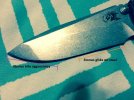- Joined
- Dec 1, 2013
- Messages
- 333
Hello,
I have had my Wicked Edge for a few months now and am getting great results but am having a similar issue on many knives. I am using the diamond stones. I have written an email to Clay and for some reason can not join the WE forums.
I am getting an uneven bevel and an issue where the stones seem to glide on the steel near the base of the knife and bite into the steel very aggressive closer to the tip. Near the base of the knife the stones sound very slippy and smooth. Near the tip is a very scratchy grinding sound. I am using the recommended settings for each knife that are listed on WE database and BF members recommendations. For the XM18 3.5 I have it set to B and 22 DPS and checked its accuracy with an angle cube. This is what was recommended on the Hinderer forums. I had to resort to stepping it back out to 23 DPS to apex the edge and form a burr because I was getting NO WHERE near the base of the blade. I want to achieve an even bevel but this issue is preventing me from doing so. Any idea as to why I am having this issue? It is not just this knife. I had the same issue on my Benchmade 940 and my Endura 4.

I have had my Wicked Edge for a few months now and am getting great results but am having a similar issue on many knives. I am using the diamond stones. I have written an email to Clay and for some reason can not join the WE forums.
I am getting an uneven bevel and an issue where the stones seem to glide on the steel near the base of the knife and bite into the steel very aggressive closer to the tip. Near the base of the knife the stones sound very slippy and smooth. Near the tip is a very scratchy grinding sound. I am using the recommended settings for each knife that are listed on WE database and BF members recommendations. For the XM18 3.5 I have it set to B and 22 DPS and checked its accuracy with an angle cube. This is what was recommended on the Hinderer forums. I had to resort to stepping it back out to 23 DPS to apex the edge and form a burr because I was getting NO WHERE near the base of the blade. I want to achieve an even bevel but this issue is preventing me from doing so. Any idea as to why I am having this issue? It is not just this knife. I had the same issue on my Benchmade 940 and my Endura 4.

